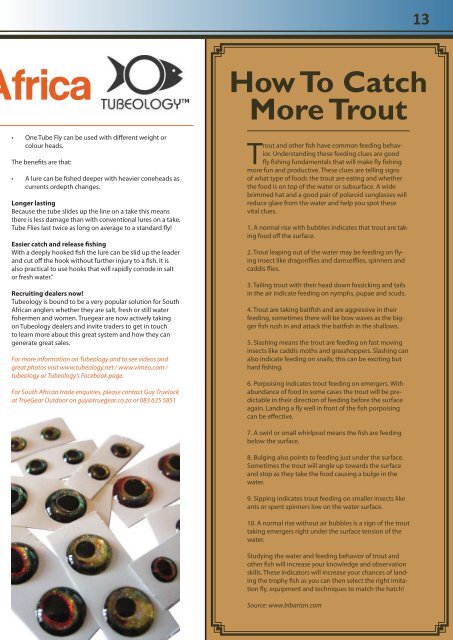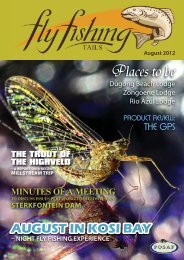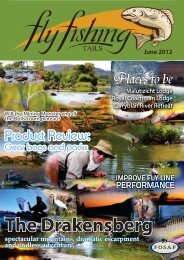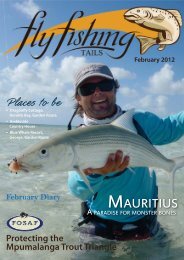Product review: reels - Flyfishingtails
Product review: reels - Flyfishingtails
Product review: reels - Flyfishingtails
You also want an ePaper? Increase the reach of your titles
YUMPU automatically turns print PDFs into web optimized ePapers that Google loves.
frica<br />
One Tube Fly can be used with different weight or<br />
colour heads.<br />
The benefits are that:<br />
A lure can be fished deeper with heavier coneheads as<br />
currents ordepth changes.<br />
Longer lasting<br />
Because the tube slides up the line on a take this means<br />
there is less damage than with conventional lures on a take.<br />
Tube Flies last twice as long on average to a standard fly!<br />
Easier catch and release fishing<br />
With a deeply hooked fish the lure can be slid up the leader<br />
and cut off the hook without further injury to a fish. It is<br />
also practical to use hooks that will rapidly corrode in salt<br />
or fresh water.”<br />
Recruiting dealers now!<br />
Tubeology is bound to be a very popular solution for South<br />
African anglers whether they are salt, fresh or still water<br />
fishermen and women. Truegear are now actively taking<br />
on Tubeology dealers and invite traders to get in touch<br />
to learn more about this great system and how they can<br />
generate great sales.<br />
For more information on Tubeology and to see videos and<br />
great photos visit www.tubeology.net / www.vimeo.com /<br />
tubeology or Tubeology’s Facebook page.<br />
For South African trade enquiries, please contact Guy Truelock<br />
at TrueGear Outdoor on guy@truegear.co.za or 083 635 5851<br />
13<br />
How To Catch<br />
More Trout<br />
Trout and other fish have common feeding behavior.<br />
Understanding these feeding clues are good<br />
fly fishing fundamentals that will make fly fishing<br />
more fun and productive. These clues are telling signs<br />
of what type of foods the trout are eating and whether<br />
the food is on top of the water or subsurface. A wide<br />
brimmed hat and a good pair of polaroid sunglasses will<br />
reduce glare from the water and help you spot these<br />
vital clues.<br />
1. A normal rise with bubbles indicates that trout are taking<br />
food off the surface.<br />
2. Trout leaping out of the water may be feeding on flying<br />
insect like dragonflies and damselflies, spinners and<br />
caddis flies.<br />
3. Tailing trout with their head down fossicking and tails<br />
in the air indicate feeding on nymphs, pupae and scuds.<br />
4. Trout are taking baitfish and are aggressive in their<br />
feeding, sometimes there will be bow waves as the bigger<br />
fish rush in and attack the baitfish in the shallows.<br />
5. Slashing means the trout are feeding on fast moving<br />
insects like caddis moths and grasshoppers. Slashing can<br />
also indicate feeding on snails; this can be exciting but<br />
hard fishing.<br />
6. Porpoising indicates trout feeding on emergers. With<br />
abundance of food in some cases the trout will be predictable<br />
in their direction of feeding before the surface<br />
again. Landing a fly well in front of the fish porpoising<br />
can be effective.<br />
7. A swirl or small whirlpool means the fish are feeding<br />
below the surface.<br />
8. Bulging also points to feeding just under the surface.<br />
Sometimes the trout will angle up towards the surface<br />
and stop as they take the food causing a bulge in the<br />
water.<br />
9. Sipping indicates trout feeding on smaller insects like<br />
ants or spent spinners low on the water surface.<br />
10. A normal rise without air bubbles is a sign of the trout<br />
taking emergers right under the surface tension of the<br />
water.<br />
Studying the water and feeding behavior of trout and<br />
other fish will increase your knowledge and observation<br />
skills. These indicators will increase your chances of landing<br />
the trophy fish as you can then select the right imitation<br />
fly, equipment and techniques to match the hatch!<br />
Source: www.bibartan.com







